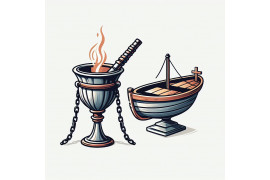Altar bells have a significant role in Catholic Mass, particularly during the Eucharist. They are used as a means of communication and reverence, following the guidelines of the roman missal. The bells are rung during the sanctus prayer. These small bells are rung at key moments during the congregation's prayer service, signaling important transitions and inviting worshipers to pay attention to the sanctus and Eucharist. One such moment is during the consecration of the Eucharist, where the altar bell rings to signal prayer and posture of people, signifying the transformation of bread and wine into the body and blood of Christ. Altar bells may be rung during Eucharistic processions or when the priest enters and leaves the sanctuary to signal prayer and gather people.
Understanding how to ring the altar bell correctly is essential for those participating in Catholic Mass. In this guide, we will explore the purpose behind ringing the altar bell, its significance within the context of worship, and provide step-by-step instructions on how to properly ring it. Whether you are new to Catholicism or simply curious about this sacred tradition, this guide will help you navigate through this aspect of Mass etiquette with confidence. Additionally, it is important to note that during certain parts of the Mass, a small bell may be used as a symbolic element.
Historical and Cultural Importance of Altar Bells in Catholicism
Altar bells have played a significant role in Catholic worship for centuries. They hold both historical and cultural importance within the Church, symbolizing the presence of Christ and marking important moments during Mass with the ringing of a small bell. The use of altar bells can be traced back to early Christian liturgical practices, where they were employed to enhance the sacredness of the Eucharistic celebration.
Symbolizing the Presence of Christ
Altar bells are considered a powerful symbol that represents the presence of Christ during Mass. When rung, they serve as a reminder to the faithful that Jesus is truly present in the consecrated bread and wine. The sound of the bell resonates through the church, capturing attention and inviting worshipers to focus on this sacred moment.
Announcing Significant Moments in Mass
The ringing of altar bells has traditionally been used to announce crucial moments throughout Mass. These include when the priest elevates the host and chalice after consecration, signifying Christ's body and blood. Altar bells may be rung during other significant parts of the liturgy, such as during the Our Father or at specific points during special celebrations like Easter Vigil.
Deep Roots in Early Christian Liturgical Practices
The practice of using bells in worship dates back to early Christianity. In ancient times, small hand bells were used by acolytes or servers to alert people outside the church that Mass was about to begin. As time passed, larger altar bells were introduced within churches themselves for ceremonial purposes.
Unique Traditions Surrounding Altar Bell Ringing
Different cultures have developed their own unique traditions surrounding altar bell ringing in Catholic worship. For example:
-
In some places, it is customary for altar servers or sacristans to ring large hand bells with long handles.
-
Certain regions may have specific guidelines regarding how many times an altar bell should be rung during different parts of the Mass.
-
In some cultures, bells are rung not only during Mass but also during processions or special religious celebrations.
These diverse traditions add richness and depth to the Catholic faith, showcasing the universal nature of the Church while honoring local customs.
When to Ring the Altar Bell During Mass
The altar bell holds a significant role in Catholic Mass, and it is customary to ring it at specific moments throughout the service. These key moments include the elevation of the host and chalice, symbolizing the consecration of bread and wine into the body and blood of Christ. The ringing of the bell adds a reverent touch to these sacred moments.
Timing May Vary Depending on Local Customs or Preferences
While there are general guidelines for when to ring the altar bell during Mass, it's important to note that timing may vary slightly depending on local customs or individual preferences. Different parishes or churches may have their own traditions regarding when exactly to ring the bell. Some communities may prefer a more frequent use of the bell, while others may opt for a more minimalistic approach.
Responsibility Falls on Altar Servers or Sacristans
The responsibility of ringing the altar bell falls upon altar servers or sacristans, who assist with various tasks during Mass. These individuals are trained in the proper procedures and timing for ringing the bell. They play an essential role in maintaining reverence and orderliness during worship services.
Key Moments for Ringing the Bell
-
Elevation of the Host: One crucial moment when you would typically hear an altar bell is during the elevation of the host by the priest. This occurs after consecration, when he lifts the consecrated bread for all to see.
-
Elevation of Chalice: Another significant moment that calls for the ringing of the altar bell is during the elevation of the chalice containing consecrated wine.
How Many Times to Ring the Altar Bell at Specific Parts of the Mass
During a Catholic Mass, the ringing of the altar bell is a significant tradition that adds a touch of reverence and solemnity to the proceedings. The number of times the altar bell is rung can vary depending on different factors such as tradition or personal preference.
Three Rings for Important Parts
One common practice is to ring the altar bell three times during specific parts of the Mass that are considered particularly important. These moments usually include the consecration and elevations.
Single Ring or Multiple Rings?
However, it's important to note that there is no hard and fast rule. Some churches may prefer a single ring, while others may opt for multiple rings for emphasis or based on their particular traditions.
Follow Parish Guidelines
To ensure consistency and unity within your parish, it's essential to follow any specific guidelines provided by your church or priest regarding the ringing of the altar bell. Different parishes may have their own customs and preferences.
It's always best to consult your priest or liturgical committee if you're unsure about how many times to ring the altar bell during certain parts of the Mass. They will be able to provide you with guidance based on your specific church's traditions and preferences.
Pros
-
Adds a sense of reverence: The sound of an altar bell can create a reverent atmosphere during important moments in the Mass.
-
Enhances focus: The ringing of the bell can help draw attention and focus towards key parts of the liturgy.
-
Reflects tradition: Following established practices regarding ringing an altar bell helps maintain continuity with historical Catholic traditions.
Cons
-
Potential distraction: In some cases, excessive or inconsistent ringing can be distracting rather than enhancing worship.
-
Varying practices: Different churches may have different customs, Which can lead to confusion or inconsistency.
Symbolism and Spiritual Meaning Behind Altar Bell Ringing
The sound of an altar bell holds deep symbolism and spiritual meaning within religious ceremonies. It serves as a powerful call that resonates with the souls of worshipers, creating a sacred atmosphere. The ringing of the altar bell signifies a momentous occasion where heaven meets earth through transubstantiation.
Significance of the Sound
The sound produced by the altar bell is not merely a noise, but rather a profound symbol in religious rituals. It carries significant meaning across various cultures and religious traditions. The bell's resonance serves as a reminder of the sacredness and awe-inspiring nature of the Mass.
A Call to Attention
When the altar bell rings during Mass, it acts as a call to attention for all those present. Just like when your teacher rings the school bell, it signals that something important is about to happen. In this case, it signifies that a significant part of the Mass is taking place or transitioning.
Marking Sacred Moments
The ringing of the altar bell often accompanies key moments during the Mass, such as during consecration or when the Eucharist is elevated. These are pivotal moments where bread and wine are transformed into the body and blood of Christ according to Catholic belief.
Enhancing Spiritual Focus
The sound of the altar bell helps worshipers focus their minds on prayer and reflection. Its gentle chimes create an atmosphere conducive to spiritual contemplation, allowing individuals to connect more deeply with their faith.
Engaging Multiple Senses
In addition to its auditory impact, ringing the altar bell engages multiple senses during worship. The sound can evoke feelings of reverence and awe, while also capturing attention visually as servers or priests ring it at specific points during Mass.
Cultural Variations
While we have focused on Catholicism thus far, it's worth noting that altar bells hold significance in other religious practices too. For example:
-
In Buddhism, the sound of bells is believed to drive away evil spirits and awaken the mind to enlightenment.
-
In Hinduism, bells are rung during puja (worship) to create a positive vibrational energy and attract divine blessings.
-
In Orthodox Christianity, bells are rung during worship services to announce the presence of God and invite worshipers into prayer.
The Ritual of Ringing the Altar Bell: A Guide for Altar Servers
Approach the Altar with Reverence
Altar servers play an important role in the Catholic Mass, assisting the priest and ensuring a smooth flow of the liturgy. It is crucial to approach this ritual with reverence. As an altar server, you should approach the altar calmly and respectfully.
Hold Firmly and Ring Gently
To ring the altar bell, hold its handle firmly in your hand. The bell can be swung gently or tapped against its side using a clapper. The key is to produce a clear sound without being too forceful. Practice beforehand to ensure a smooth and controlled ringing motion.
Pay Attention to Cues
As an altar server, it's essential to be attentive to cues from the priest or other liturgical ministers regarding when to ring the bell. These cues may include specific moments during the Mass or certain prayers mentioned in the Roman Missal.
Follow Liturgical Guidelines
The ringing of the altar bell has specific purposes within the context of Catholic worship. It serves as a signal for important moments during Mass, such as when bread and wine are consecrated into the body and blood of Christ. Familiarize yourself with liturgical guidelines and instructions provided by your parish or diocese on when to ring the bell.
Example Scenarios
Let's explore some example scenarios where you may need to ring the altar bell:
-
During Consecration: When performing transubstantiation, where bread and wine become Jesus' body and blood, you may be asked to ring the bell three times at specific moments.
-
Elevation of Host and Chalice: After consecration, when both the host (bread) and chalice (wine) are elevated by the priest for all worshipers to see, you may also need to ring.
-
Processions: During processions, such as the entrance or recessional, you may be asked to ring the bell to signify important moments of movement.
Embracing the Sacred Tradition of Altar Bell Ringing
We learned about the specific moments during Mass when the altar bell is rung and how many times it is traditionally done. We also delved into the symbolism and spiritual meaning behind this ritual. Finally, we provided a comprehensive guide for altar servers on how to ring the altar bell properly.
Now that you have a more in-depth understanding of the significance and practice of ringing the altar bell, we encourage you to embrace this sacred tradition in your own worship. As you participate in Mass, take note of these moments and let the sound of the bell deepen your connection to the divine. By engaging with this age-old practice, you can enhance your spiritual experience and contribute to the rich tapestry of Catholic liturgy.
FAQs
Can anyone ring the altar bell during Mass?
Yes, usually it is an assigned role for an altar server or someone specifically designated by the priest. However, depending on local customs or circumstances, there may be exceptions where others are allowed to ring the bell under supervision.
Are there any specific guidelines for how loud or soft the bell should be rung?
While there are no strict rules regarding volume, it is generally recommended to ring with a gentle yet audible tone that does not overpower other elements of worship. The goal is to create a reverent atmosphere without causing distraction.
Is ringing an actual physical bell necessary? Can electronic alternatives be used?
Traditionally, physical bells have been used for their symbolic significance and acoustic properties. However, some churches may use electronic alternatives due to practical considerations or accessibility issues while striving to maintain reverence and respect for tradition.
Do different cultures within Catholicism have variations in their use of altar bells?
Yes, there can be slight variations in when and how altar bells are rung based on cultural traditions within Catholicism. It is always best to consult your local parish or diocese to understand any specific customs that may be observed in your community.
Can altar bells be used outside of Mass?
While the primary use of altar bells is during Mass, they can also be used for other sacraments and liturgical ceremonies within the Catholic Church. The specific occasions may vary, so it's advisable to consult your priest or liturgical coordinator for guidance on their appropriate usage.



